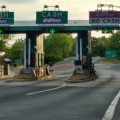The Electric Road Trip
The technology keeps improving with electric cars, and it’s becoming much easier to take long trips without concern for being stranded. Yours truly explored and wrote about this for the Fall 2019 issue of JerseyMan magazine; you can view the PDF of the article here.
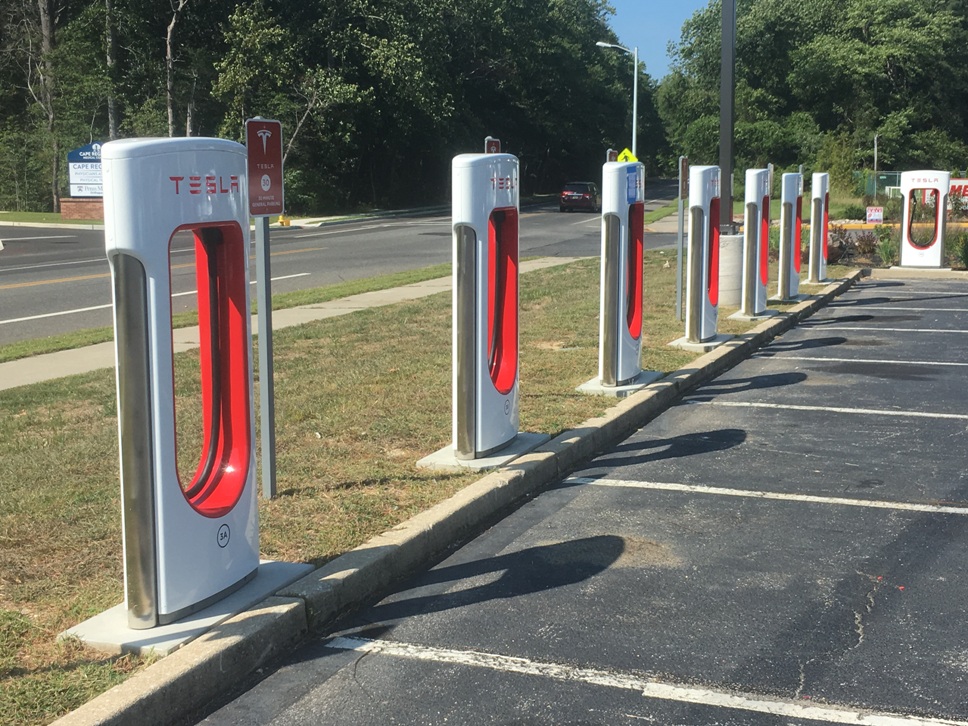
Plenty of juice available.
The Electric Road Trip
Car charging stations are springing up rapidly everywhere these days, making long-distance travel much easier for electric vehicle owners.
Sure, I want to save the planet from carbon emissions. Our children’s future depends on it. But is it really worth being stranded on I-95 on the way to Florida in my electric car?
Okay, maybe we’re not that spoiled. Despite some limitations compared to fuel-powered vehicles, electric vehicles are selling pretty well these days. We just need to solve that range problem.
As recently as 2016, McKinsey Industries, a firm dedicated to sustainability solutions, listed limited availability of charging stations as the third biggest barrier to electric vehicle sales, after the price of cars and limited driving range. Most EV owners still charge their cars at home, and owners of less expensive EVs with shorter ranges generally use them only for daily commutes and short trips.
But we are a nation of doers, and that situation is changing fast.
In May 2019, the Department of Energy reported that there are now more than 68,000 charging units in the U.S., nearly 11,000 of which are fast charging stations that can “fill up” an EV in less than 20 minutes. The Tesla superchargers appearing in many spots, including Wawas in the area, are only compatible with Tesla vehicles. But other networks are growing for the rest of us.
You may not have heard of EVgo, but you’ve probably seen the name NRG on the Broad Street Line’s Sports Complex station. Same company. EVgo offers DC fast charging…the fastest form available as of 2019…in 66 metropolitan markets from their considerable grid. As EVgo states, you can charge your car to 80% in approximately a half hour, while you stretch your legs, grab a bite, and take care of other business.
With new apps like PlugShare and ChargeHub available to route you to the next charging station, your biggest challenge on long road trips now is not spilling coffee on your phone.
Bill Evans, the CEO at Liberty Fox Technologies and one of our esteemed Legacy Club members, is the proud owner of a Tesla Model S.
The Model S isn’t cheap…it currently carries a price tag of $75K. If you’re a tightwad, you can drive a Model 3 off the lot for under $40K. If it helps, remember you’re going to be saving a lot of money in fuel over the long haul, even without the free supercharging for life offered to Model S owners.
Evans likes a lot of things about his Model S, but he considers the fuel savings to be “a nice perk”.
“I tend to drive between 1,800 and 2,000 miles per month. In my previous vehicle, I was averaging about $250 a month in gas. For the same mileage, I am averaging $80 per month in electric. So I am using about 1/3 the cost in electricity as I was in gasoline.”
The cost savings is generally typical of EVs. A Chevy Bolt currently averages 25.21 kWh (kilowatt hours) per 100 miles. So at 13 cents per kWh (the national average, according to the U.S. Department of Energy), then 100 miles would cost about $3.25. Even for the most fuel-efficient cars, that soundly beats gas prices.
But if you’re considering buying an electric vehicle to save money, we’re not quite there…yet.
In July 2019, U.S. News & World Report listed the cheapest electric vehicle as the Smart EQ Fortwo, at nearly $27K. The Fortwo is aptly named…attempting to shoehorn three people into one of these might make for a humorous YouTube video. Second is the Nissan Leaf at just under $30K, which is more spacious and offers 150 miles of range on a charge. Good for daily commutes…for longer road trips, maybe not so much.
But compared to the limited range technology of not very long ago, this is quite the improvement, and Tesla CEO and extreme visionary Elon Musk has stated that one of his company’s goals is making electric vehicles available at prices the 99% can afford. Given their great strides of late, this seems much more attainable than, say, colonizing Mars. (Which is also on Musk’s to-do list).
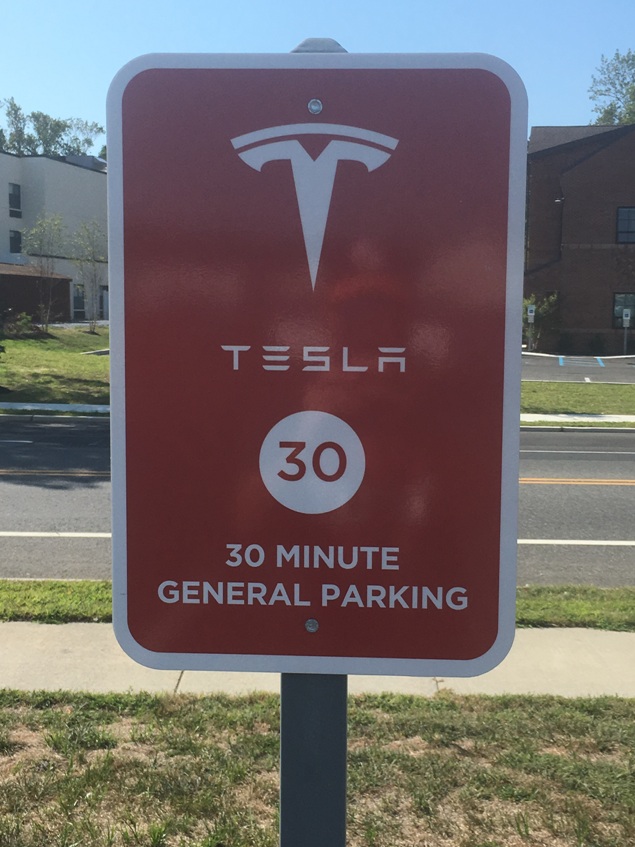
While you’re waiting, give your Tesla manual a read!
While the convenience and cost of owning an electric vehicle continues to rapidly improve, longer trips still require more planning. It’s not terribly difficult, but it requires more than simply pulling off the road at a Wawa.
For one, it takes longer.
A Level 1 charge is the equivalent plugging your car into a 120V outlet in your home, and can handle your short commute within reason if you charge overnight. With a Level 2 charge in a 240V outlet, available at most charging stations or from an adapter for your home, it takes about 4-8 hours to fill up. A DC Fast Level 3 charge gets the job done in less than a half hour.
Evans describes charging his Tesla like this: “If you plug the Tesla into a regular 120-volt outlet like you’d plug in your television, the car could take up to three days to fully charge (which is absurd). If you use a higher voltage outlet, the car can fully charge in about 5 hours.
“But if you need the car to charge really fast, you can get a very powerful charge at the supercharging station in as little as 15 minutes…and Tesla is working to reduce this even further to about five minutes. At 15 minutes or less, I would say it is no less convenient than a conventional car.”
But it’s still not quite as fast as the gas pump, which is why Tesla has been smart enough to install Supercharger stations at gas station/convenience shops, including some Wawas, Royal Farms, and other stores in the area. It works great for the store owner…the charging EV owner can spend time in the store ordering a sandwich or coffee while they wait.
Another growing spot for chargers is an obvious one…hotels. As of this writing, Marriott offers Level 2 charging stations at 3,137 of their hotels, including the Courtyard on Presidential Boulevard in Philly. Something to consider when choosing where to sack out in South Carolina on your way to Disney.
One important caveat, though…plan your trip to avoid the isolated station on the busy highway if you can. That could be a busy place. It’s a problem that internal combustion engine cars had in their early days.
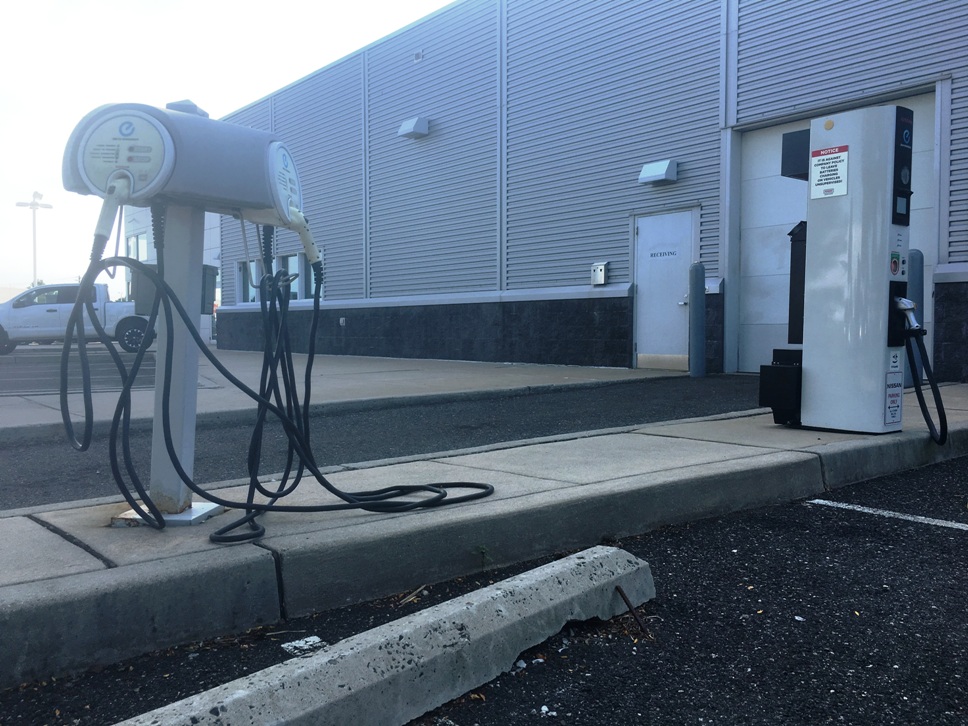
Car chargers at the Turnersville NJ Nissan dealership, where charging is free to customers.
With a rapidly expanding network of charging stations and dropping prices of electric vehicles, we may all be able to hit the road to visit a few ballparks without emissions in the not too distant future.
As recently as April 2017, Eric Schaal at Motor Biscuit published a piece called “5 Biggest Problems With Electric Vehicle Charging”. In it he explained that it’s more challenging to charge your electric car…especially while you’re already on the road…than it is to simply stop at a pump and fuel up.
“It’s quite difficult to fast-charge your car in many U.S. cities, even when money is no object.” Schaal pointed out. “You have to drive through strange neighborhoods and try to locate chargers in vast parking lots where GPS is known to drop out of service.”
The apps help, but not as much as they should, according to Schaal. “You might need two or three apps just to know where a charging station is, and once you get there you might not be able to use it because it’s operated by a provider with whom you haven’t opened an account.”
Just two years later, Bill Evans can testify that Tesla owners, at least, don’t need to be concerned about being stranded on the highway.
“You really, really need to be neglectful to put yourself in this position,” Evans explains. “If you charge the car every day like I do, you start every single day with your full mileage range (240 miles or 330 miles depending on your model). Given that I rarely ever drive 240+ miles in a single day, this is really a fringe case.
“Secondly, as long as you are using the GPS feature of your car, the Tesla is fully aware of its range, and if it is concerned you won’t reach your destination, it will route the most convenient Supercharging location into your directions to make sure you stop and top off before continuing.
“To end up on the side of the road with a dead Tesla and no chargers requires that you ignore every single warning and recommendation from the car to force that situation to occur.
“If you started in New Jersey and wanted to drive to Disney World, the Tesla will route multiple supercharging stops along the way and include the charging time at each in the projected Estimated Time of Arrival. As long as you use the GPS, the car will plan the entire drive and charging locations.”
And once there are charging stations at South of The Border, it’s likely the Northeast will be all in.
Did this post make your day a little bit?
I hope so. If it did, I would really appreciate your support.
When you use this link to shop on Amazon, you’ll help subsidize this great website…at no extra charge to you.
Thanks very much…come back soon!
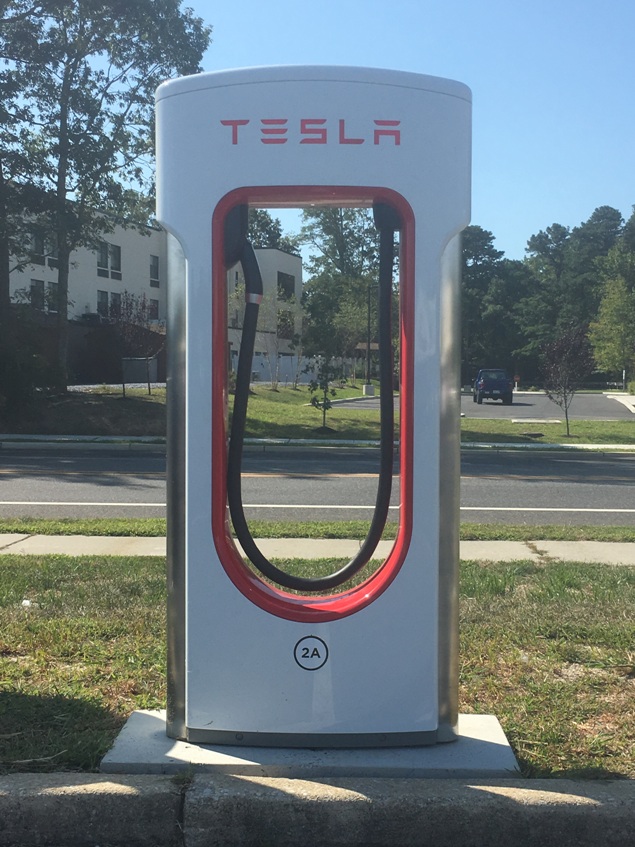
Stop waiting for the car to drain. It won’t help. Just do it.
Battery Myth No. 1 – Full Drainage
JerseyMan Magazine always goes the extra mile for its readers, so in addition to the useful information contained here, we can dispel a myth for you.
You’ve probably heard it before: let your smartphone drain completely before charging it up again. This will…supposedly…help your phone battery last longer. And it stands to reason people might find that useful with their electric car, too.
Here’s the real scoop from our friends at Mashable: “It’s better to charge your phone every day than to do a ‘deep charge’ from time to time. Lithium-ion batteries, like the kind used in Samsung and Apple products, fare better when they’re charged. If you constantly let them drain to 0%, they become unstable. Your battery has a finite number of charge cycles, and every time it fully dies, that’s another cycle out the window.”
Leaving aside that you would have to let your car idle for an extended period of time near a charging station, this applies to your electric vehicle’s battery…completely draining it can reduce its overall life too.
So there’s no need to time your car charging station visit to the kilowatt hour. Or wait for your phone to completely discharge, for that matter. A helpful tip at no extra charge!
Battery Myth No. 2 – The Colder, Longer Lasting Battery
In case you’re wondering, no, putting your EV battery in a freezer won’t make it last longer.
Like with gas-powered engines, EVs can suffer decreased performance and range in extreme cold weather. There are several reasons for this, including that the electricity running your car’s heater uses the same battery that is plowing a car through the snow.
But before you balk at buying a new Bolt out of concern for New Jersey’s sometimes biting winters, consider this: Norway…yes, Norway…is one of the world’s leaders in adopting the electric vehicle. Part of the reason is subsidies, but it’s hard to imagine Norwegians buying cars that don’t work in the cold.
Yes, there is definitely decreased range in electric vehicle batteries in below freezing temps, more so than in fuel-powered cars. But there are ways to overcome this, including “preconditioning”, or pre-heating your battery before it is finished charging, similar to remotely starting up your car before driving. Many EV models have this capability.
John Voelcker from the Green Car Reports blog also suggests bundling up and leaving your coat and layers on in the car. While it may be cringe-worthy to pay upwards of $30K for a car that still requires wearing a coat to drive, Voelcker adds: “Don’t worry if you think you look like a dork; the real dork is the guy stranded on the side of the road because he ran out of juice.”
Incidentally, extreme heat can do a number on your battery too, since batteries contain fluid that evaporates in high temps. Even more so than with fueled cars, it’s recommended that drivers park in the shade or in garage whenever possible.
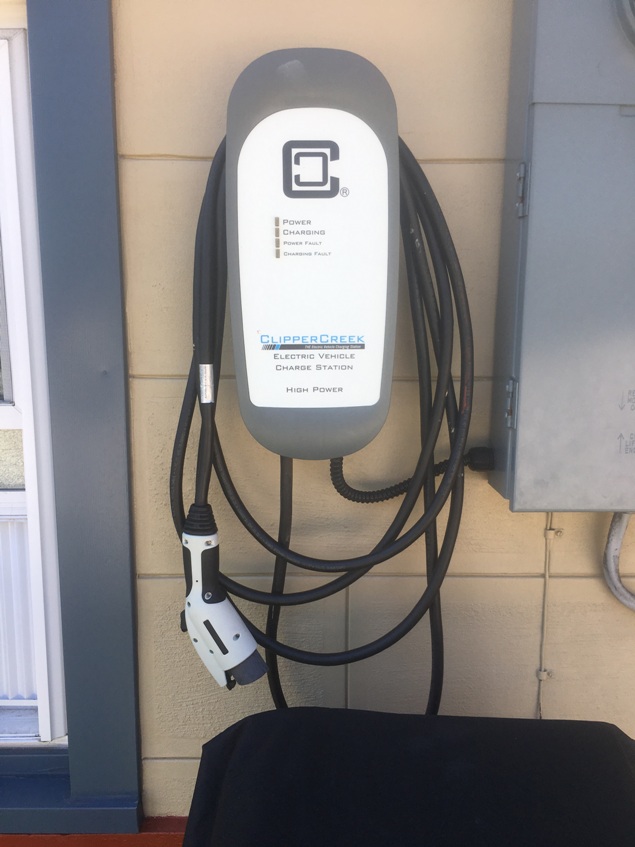
At the Candlelight B-n-B in North Wildwood, there’s only one charger. Don’t hog it.
Car Charging Station Etiquette
With charging stations still not quite as readily available at gas pumps, there is something of an unwritten code of conduct regarding their use.
One of the more common issues, according to Green Car Reports, is called “ICE-ing”. It’s when a car with an internal combustion engine parks in a spot with a charging station reserved for electric cars. If you can’t page security in the garage, the most you can do is leave a note for the driver.
Green Car Reports recommends other guidelines for using charging stations. For one, don’t occupy the space longer than you need to for a recharge, even if it’s a parking spot. If you can’t get to your car to remove the plug, you can leave a note for other drivers that they can remove it if they see your car is fully charged.
Also, if you can make it home, leave the charging station for someone else. They could be down to their last few miles and need the charge more than you do.
With their Supercharging stations, Tesla is somewhat enforcing charging station etiquette with an “idle fee”. If you keep your car at a busy charging station more than five minutes after your car is charged, a fee is charged on your account. Tesla states that this isn’t intended for profit…it’s working towards the goal of keeping charging stations as available as possible.
Basically it comes down to treating a charging station the same as a gas pump and not leaving your car there…but more so for now, at least until we go full electric.














